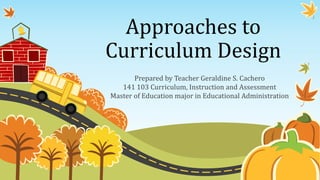
Approaches to Curriculum Design
- 1. Approaches to Curriculum Design Prepared by Teacher Geraldine S. Cachero 141 103 Curriculum, Instruction and Assessment Master of Education major in Educational Administration
- 2. Content • Features of a Curriculum 1. Who teaches? 2. Who do the teachers teach? 3. What do the teachers teach? 4. How do teachers teach? 5. How much of the teaching was learned? 6. With whom do we teach? • Approaches to Curriculum Design 1. Child or Learner-Centered Approach 2. Subject-Centered Approach 3. Problem-Centered Approach
- 3. SIX (6) FEATURES OF A CURRICULUM
- 4. 1. Who teaches? • Quality education requires quality teachers. THE TEACHER • With the advances in communication technology, good teachers are needed to sort out the information from the data that surround the learners. • The right individuals who are expected to be recruited are those with excellent and relevant preparation. • These teachers should be given support with their continuing development in order to keep abreast with the changing demands of a learning society.
- 5. 2. Who do the teachers teach? • The learners are at the center stage in the educative process. THE LEARNERS • Teachers should understand and accept the learner’s diverse background. • Considering the domain of diversity of learners will allow the individual learner to develop his multiple intelligences at his own pace. • Their needs should be addressed and be met.
- 6. 3. What do the teachers teach? • “To help the learners cope with rapid changes to understand and to succeed in the new work in the workplace, we must design a curriculum oriented to tomorrow.” KNOWLEDGE, SKILLS and VALUES • It should be remembered that what students learn will be obsolete in ten years, and half of what they need to know to succeed in work and in life has not yet been fully developed and will have to be learned as they go along in the future.
- 7. 4. How do teachers teach? • For teachers to teach effectively, they must use appropriate methodologies, approaches and strategies “capped with compassionate and winsome nature”. STRATEGIES and METHODS • Situations should be created to encourage learners to use higher order thinking skills. • Good teachers utilize information derived from assessment to improve teaching and learning and adopt a culture of excellence.
- 8. 5. How much of teaching was learned? • A curriculum should be clear at the beginning with what knowledge, skills and values should be developed by the learners. PERFORMANCE • At the end of the teaching act, it is necessary to find out if the objectives set were accomplished. • Performance is a feature of a curriculum that should be given emphasis.
- 9. 6. With whom do we teach? • While teachers are the focal point in the learning process, they must draw upon the resources of their environment and of their partners to be effective. COMMUNITY PARTNERS • Partnership is a means and not an end to be pursued in itself. • However, as society changes, teachers will have a new beginning, an opportunity to recast their role in their communities, to change their attitude to their communities, to change the attitude of their communities and societies about them.
- 11. Child or Learner-Centered Approach • The learners are at the center stage in the educative process. The curriculum is built upon the learner’s knowledge, skills, learnings and potentials.
- 12. Child or Learner-Centered Approach • From its design how should a child-centered or learner-centered curriculum be approached? 1. A new respect for the child is fundamental. 2. A new freedom of action is provided. 3. The whole activity is divide into units of work. 4. The recognition of the need for using and exploring many media for self-discovery and self-direction is embraced.
- 14. Subject-Centered Approach • Anchored on the curriculum design which prescribes different and separate subjects into one broad field 1. The primary focus is the subject matter. 2. The emphasis is on bits and pieces of information which are detached from life. 3. The continuing pursuit of learning outside the school is not emphasized. 4. The subject matter serves as a means of identifying problems in living.
- 15. Problem-Centered Approach • This approach is based on a curriculum design which assumes that in the process of living, children experience problems. 1. The learners are capable of directing and guiding themselves in resolving problems. 2. The learners are prepared to assume their civic responsibilities. 3. The curriculum leads the learners in the recognition of concerns and problems and in seeking solutions.
- 17. REFLECT •Schools that adhere to the subject- centered approach make robots out of the children.
- 18. REFLECT •In schools which embrace the child- centered approach, discipline is weak.
- 19. REFLECT •Why should lessons revolve around problems? There are too many to be solved.
